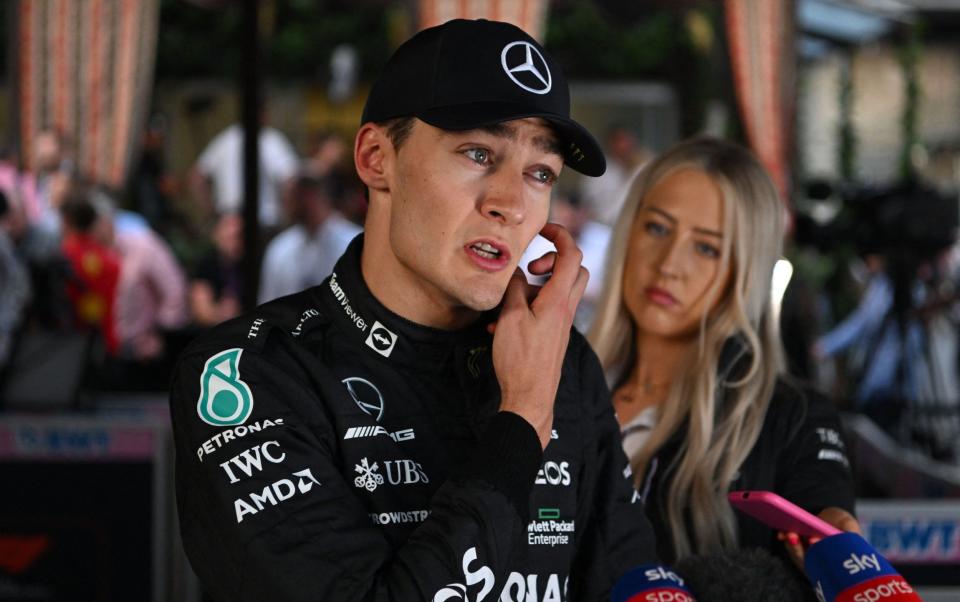Why Mercedes' car is bouncing so much and what the 6G impacts are doing to Lewis Hamilton's spine

After eight consecutive constructor titles, in 2022 Mercedes have fallen off the pace and are no longer in contention for victories. Both Lewis Hamilton and George Russell have had to hope for retirements ahead of them to snatch a spot on the podium.
And in Azerbaijan they also had to contend with, what they say, is the most uncomfortable driving experience of their lives due to persistent bouncing.
They are not the only team to suffer, but it was evident just how much Hamilton was afflicted as he struggled out of his car after the chequered flag in Baku.
Why did Mercedes suffer so badly in Baku?
Eight races in and it appears that Mercedes are not a great deal closer to (i) unlocking the potential speed in their car or (ii) reducing the bouncing enough to give their drivers a comfortable ride.
The team's specific struggles in Azerbaijan – with its long and bumpy pit straight – were due to a combination of problems, says former Jordan and Jaguar technical director Gary Anderson.
“In Monaco, where a car never really gets that low to the ground, Mercedes had major problems with their car over the bumps. This should have highlighted to them that their suspension control seems to be inadequate,” he says.
“In Azerbaijan they had the same problem, plus porpoising down the long pit straight.”
“All of the cars are suffering this issue to some extent but the Mercedes is doing it much more because of the aerodynamic concept on their car, coupled with the poor ride control.”
What is the physical effect on the drivers’ bodies?
The forces going through Hamilton’s spine have been reported as high as 6G at points in the race in Baku. His discomfort was clear to see and hear during and after the race. Other drivers like Daniel Ricciardo also complained of feeling “rattled”. Russell has spoken out on numerous occasions about fears for the long-term health of the drivers due to the “brutal” bouncing. Their concerns are backed up by opinions by medical professionals.

“Considering the anatomy of the spine and the unique position of the driver inside the cockpit, it’s easy to understand how the porpoising effect can have a huge impact on the driver’s spine,” says Dr Matteo Bartalucci, Head of Medical Services at Formula Medicine, which provides physical training programs to drivers.
“When the car bounces up and down, the cervical and dorsal spine have to cope with this additional overload and that must be supported by the intervertebral discs, which act as shock absorbers and provide stability to the spinal column.”
We are only eight races into a 22-race season, so there should also be worries for the medium-long term for some of the drivers. It could lead to something more serious later on.
“Repeated stress exerted upon the spinal discs can lead to disc degeneration which cause the central part of it (nucleus pulposus) to spill through a tear created in the weakened outer ring of the disc (annulus fibrosus), with consequent compression of the spinal cord and/or of the nerve roots,” Dr Bartalucci says.
It is also not out of the question that drivers might need to miss races later in the season, depending on the extent of the spasms and spillage.
It was noticeable that Russell did not seem to suffer them to the same degree as Hamilton. Age could be a factor in this, says Dr Bartalucci.
“Generally speaking, as for many other medical issues, the younger the better. This is not to say that Lewis Hamilton is old, but he has many more years of motorsport ‘on his shoulders’ compared to Russell.”
“Furthermore, disc degeneration is more likely to happen at older age due to disc dehydration and reduced flexibility,” he adds.
Why are Mercedes experiencing this worse than others?
Unlike Red Bull and Ferrari, Mercedes’ divergent aerodynamic concept is partly why they are suffering so badly.
The main ‘concept’ of their 2022 car is the slim side pods (so called ‘zero pods’) and this means that more of the floor is exposed. The regulation changes for this year mean that a greater percentage of downforce comes from the floor compared to previous years.
Mercedes are trying to generate more downforce from the under-floor of the car than their rivals, according to Anderson.

 Yahoo Autos
Yahoo Autos 